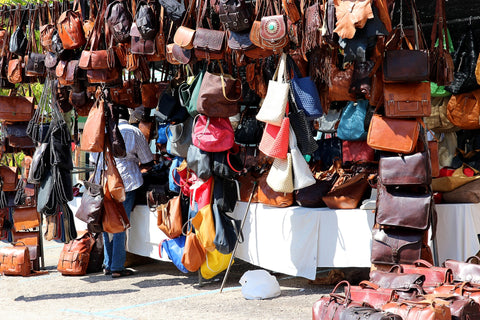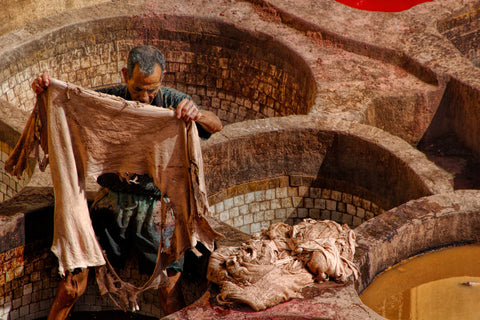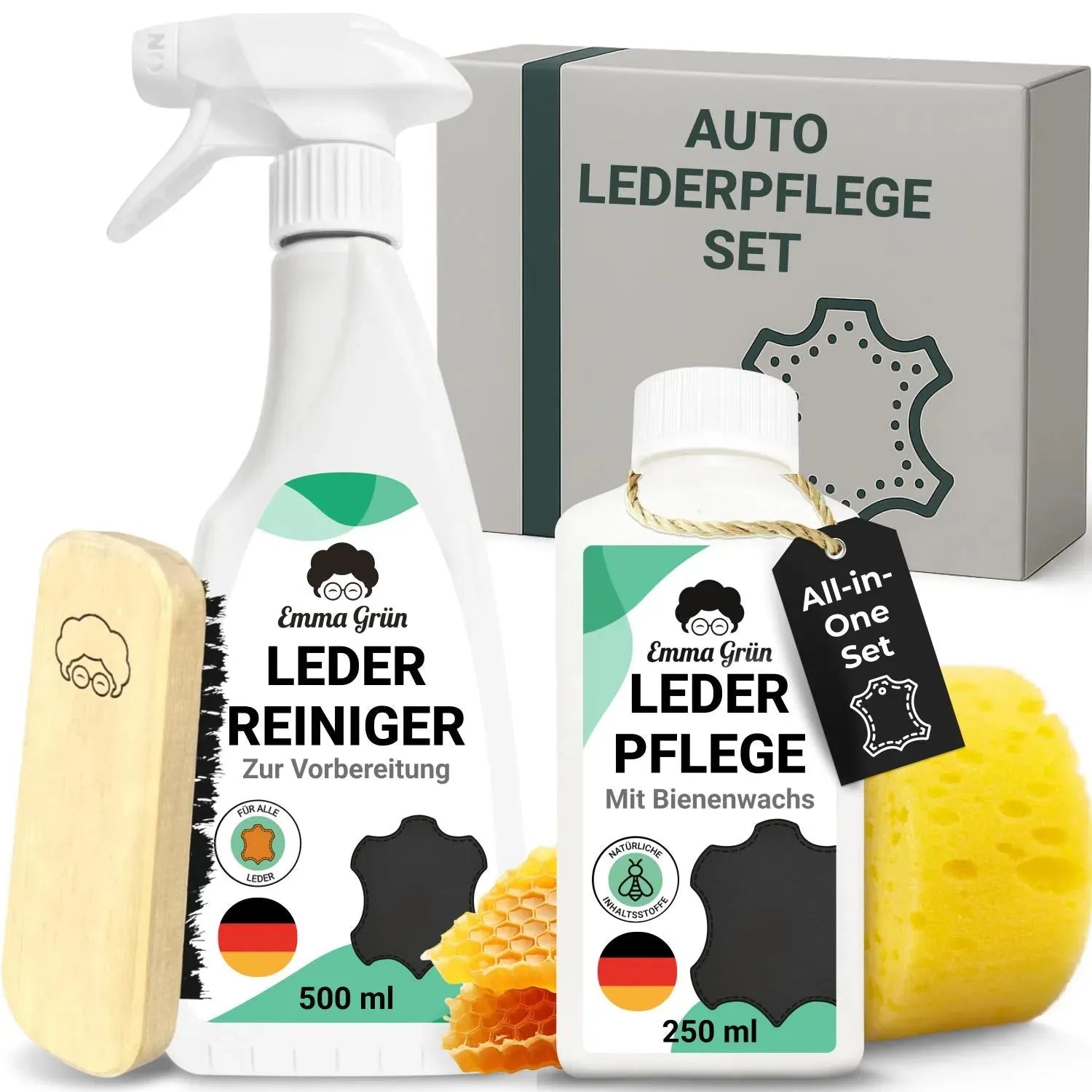Do you like high-quality leather products, but don't really know much about the manufacturing process of this fascinating material? In the following text, we'll take you on a journey into the world of leather production. You'll be amazed at how much work and skill goes into every piece of leather. We're sure: By the end of this article, you'll be a little wiser and will definitely appreciate your favorite leather pieces even more.
What is leather?
Leather is a durable and versatile material made from the skin of animals such as cattle, sheep or goats . It is very popular due to its durability and aesthetic appeal. It is used in a wide variety of products such as shoes, clothing, bags, accessories, furniture and car interiors . To make it durable, improve its strength and protect it from deterioration, it goes through the process of tanning before being processed .
Leather can be made from different animal hides. Cowhide is one of the most common and well-known. It is durable and is usually used for products such as shoes and purses. Sheepskin is softer and is mainly used for clothing, while goatskin offers a good balance between durability and suppleness and has a wide range of uses.

Image source: Pixabay
The tanning process is crucial to transforming animal hide into leather . It involves stabilizing animal proteins to make the material durable and supple, but methods such as vegetable and chromatic tanning are the most commonly used today.
There are different types of leather suitable for different uses. Full grain leather is the highest quality and retains the natural texture of the skin. Split leather is made from the bottom layer of the animal's hide and is slightly more expensive. Exotic leathers such as crocodile or ostrich leather are rarer and more luxurious. The purchase costs of products of this type are therefore on the higher end.
In order to keep leather products in good condition, however, they must be treated regularly with the right care products . Natural cleaners, waxes, emulsions and waterproofing agents such as the leather care products from Emma Grün are ideal for this. In direct comparison with conventional products , they care for, nourish and protect the natural material deep down using effective household remedies without closing the pores . This means that the breathability of the leather is not restricted and your favorite pieces retain their unique appearance.
On top of that, you should protect your favorite leather items from external influences such as UV rays and moisture. This will create the best conditions and give your leather products a long life. But what steps are actually necessary to make beautiful leather products from untreated animal hides?
Leather production: The long journey from untreated animal hides to the final product
Leather production involves a great deal of effort. Turning raw animal hide into durable, supple leather requires time and various work steps.
Step 1: Choosing the right raw material
The quality of leather starts with choosing the right raw material. In most cases, leather is made from animal hides, with cow and calf hides being the most commonly used . These hides are carefully selected to ensure that they are free of defects and have a high density of fibers. This is crucial for the durability and quality of the final product.
Step 2: Soaking the leather
During the so-called soaking process, the raw animal skin is cleaned. This is important to remove dirt and preservatives . In addition, this step ensures that the natural material retains its natural moisture content and prepares it for further processing.
Step 3: Liming the leather
Liming involves adding lime and sulphur compounds to the leather to remove hair and the top layer of skin. This step prepares the hide fibres for tanning .
Step 4: Fleshing the leather
During fleshing, the subcutaneous connective tissue, meat residues, and non-collagenous proteins and fats are removed from the animal skin using sharp blade rollers.
Step 5: Splitting the leather
Now the hide is split into two layers. The grain side (nappalan leather) and the flesh side (suede) can then be used to make different types of leather products.
Step 6: Tanning
The next step is tanning. This is the most critical step in leather production. Tanning involves treating the hide with tannins, acids or other chemicals to make it resistant to rot and heat. The tanning process also gives the leather its desired properties.
There are different types of tanning. The most common methods are vegetable tanning and chrome tanning . Vegetable tanning uses plant extracts, while chrome tanning uses chromium salts. Each method has its own advantages and disadvantages, which we will discuss in more detail at a later point. However, we can already reveal one thing: both methods are used to create a durable leather product.
Step 7: Wilting the leather
During the wilting process, large rollers are used to remove excess water from the leather and achieve an even thickness.
Step 8: Sorting the leather
Before the leather can be further processed, the material is sorted according to various quality criteria.
Step 9: Wet finishing
The acid used in tanning is neutralized in this process and the leather is dyed and oiled depending on its intended use.
Step 10: Drying the leather
To prevent shrinkage or deformation, the leather is now dried. Depending on the type of leather, different methods are used.
Step 11: Studs of the leather
The leather is now mechanically processed. This step serves to loosen the fibers and improve the texture of the material.
Step 12: Hydrophobization
During hydrophobic treatment, the leather is impregnated with special agents , making it water and dirt repellent.
Step 13: Dyeing and finishing
After tanning, the leather is dyed and finished. This step gives the material the desired color and texture . The type of dyeing can be done using natural dyes or synthetic colors. Finishing provides additional layers of protection and gives the leather its characteristic shine or mattness.
Step 14: Cutting and processing
The dyed and refined leather is now cut and processed into the desired products. This is where the craftsmanship of the leather craftsmen comes into play. From bags to shoes to furniture - the possibilities are almost endless.
Step 15: Quality control and final inspection
Before the leather product reaches the consumer's hands, it undergoes a strict quality control. Every cut, every seam and the entire surface is checked for defects. This guarantees that only the highest quality products leave the production facilities.
Which tanning processes are used to produce leather?
Tanning leather is a crucial step in the production of high-quality leather products. The organic raw material, namely the animal skin, is converted into durable leather. This happens through a chemical reaction in which the tanning agents form a permanent bond with the skin fibers. This process serves to preserve the animal skin for the long term and prevents it from decaying and hardening . The following tanning methods are used to preserve leather:
- Chrome tanning
- Vegetable tanning
- Tanning
- Alum tanning
- Synthetic tanning
To give you an idea of which external features and properties indicate which type of tanning and which substances are used in the respective tanning process, we have briefly summarized the different procedures and the subsequent appearance of the leather in the following paragraph.
- Real tanning: With real tanning, such as chrome tanning and vegetable tanning, the bond between the skin fibers and the tanning agents is permanent and stable . Chrome tanning, which has been the most common method since 1900, is carried out using chromium salts of hydrochloric acid that are harmless to health and is characterized by a short production time of just a few days. At the end of the tanning process, the leather has a bluish-gray color.

Image source: Pixabay
- Vegetable tanning: Vegetable tanning is an ancient process that uses only natural plant materials such as oak or spruce bark . At the end of the tanning process, the leather has a brownish color.
- The fake tanning : The fake tanning, which includes alum tanning and blubber tanning, creates an unstable bond between the leather and the tanning agents, making the leather sensitive to moisture and heat. Blubber tanning, one of the oldest tanning methods known, uses the oxidation of blubber (fish oil) and gives the leather a yellowish color. On the other hand , alum tanning is done with aluminum salts and results in very sensitive leather with a white color .
- Synthetic tanning: Synthetic tanning uses artificially produced substances such as formaldehyde, glutaraldehyde, phenol and acrylate. This type of leather is sensitive to moisture and heat and is often used in combination with chrome tanning or vegetable tanning.
Conclusion
Leathermaking is an art that combines craftsmanship, science and passion. From the selection of raw materials to the quality control at the end of the process, every detail is considered to ensure that you acquire a product that is not only beautiful but also durable. The next time you hold a piece of leather in your hand, remember how much work and know-how has gone into this fascinating material and pamper it with the right care at regular intervals to ensure it lasts a long time.
FAQ: Questions & Answers
How is raw animal skin turned into durable leather?
Leather production goes through several steps, including tanning, dressing and dyeing. The process begins with tanning, where the animal hide is treated to make it durable and prevent it from spoiling. The leather is then dressed to achieve the desired thickness and smoothness. Finally, the leather is dyed and further processed.
What types of tanning processes are there?
There are several tanning processes, including vegetable tanning, chromatic tanning and mineral tanning. Each method has its own advantages and disadvantages, and choosing the right process depends on the intended use of the leather.
Which animal skins are commonly used for leather production?
The most common animal hides used for leather production come from cattle, sheep and goats. Cow leather is tough and is often used for shoes and furniture, while sheep leather is softer and popular in the clothing industry. Goat leather offers a good balance between durability and suppleness.
What types of leather are there?
There are different types of leather, including full grain, split and exotic types of leather such as crocodile or ostrich. Full grain leather is the highest quality and retains the natural texture of the animal's skin, while split is made from the bottom layer of the skin and is less expensive.
What is the best way to care for leather products?
Caring for leather products is important to ensure their durability. This includes using leather conditioners, avoiding excessive exposure to sunlight and heat, and protecting from moisture. Customers should also be advised on how to properly care for their leather products.
Can leather be produced sustainably?
Yes, there are sustainable practices in the leather industry, including using eco-friendly tanning processes and supporting animal welfare policies. Customers who value sustainability should look for products that carry appropriate certifications.
reference
1. The leather industry – www.lederzentrum.de/wiki/index.php/Lederindustrie
2. Production of leather and leather goods in Germany – www.ibisworld.com/de/branchenreporte/herstellung-leder-lederwaren/1471/
3. How is leather made? – www.lederpflege.de/Herstellung
4. Leather production – www.braun-bueffel.com/ledertipps/herkunft/leder-lederherstellung-erklaerung.html
5. Leather production – www.deder-info.de




